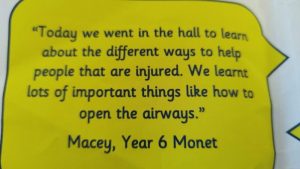Ageism is stereotyping and/or discrimination against individuals or groups on the basis of their age which may be casual or systemic. The term was coined in 1969 by Robert Neil Butler to describe discrimination against seniors and patterned on sexism and racism.
As it states, is it discrimination, which can direct or indirect, against somebody because of their age and this goes either way!
Here at ABC Life Support, we believe in training and access to this training for everybody and some of the content that we deliver is going to be specific for a particular age range, e.g., Youth Mental Health First Aid and Paediatric First Aid Training and within these disciplines there may be amendments that can be made to accommodate the learner.
Here are a few examples where the age of the learner may be taken into consideration.
Round Diamond School
Teaching First Aid to Year’s 5 and 6
Danielle and Robin delivered first aid training to 4 groups of students at this progressive and engaging school in Hertfordshire. They have taken the requirements to teach first aid at school in a practical way, asking the professionals to do the job! If you are interested in what the law states is a requirement for what young people need to know about first aid in primary and secondary school, take a look here – Primary and Secondary School First Aid requirements.
Cavendish House Defibrillator Workshop
Danielle was asked to deliver a defibrillator workshop to a group of elderly residents and afterwards, she talked about how very interesting the course was. Here is Danielle talking about the experience.
Thankfully the defibrillator at Cavendish Court stands idle but if the need arose the residents had said they would be very wary of using it. Danielle was recommended and she visited us free of charge to demonstrate not only how to use the defibrillator but discuss the importance of first aid.
The residents were understandably a little daunted but Danielle’s engaging style made the session entertaining which soon put them at ease. They commented after, they had enjoyed the demonstration and felt more confident and better prepared to help people if needed.
Sue
Reasonable adjustments
In terms of other differences, or enhancements in terms of practical first aid training, the protocols around the delivery of CPR and choking can also be marked.
When we talk about babies and children’s CPR, it is important to understand that breath is super important. Here are the reasons why.
- Most causes of paediatric cardiac arrest are due to respiratory failure which means that their breathing stopped first. This also means that the oxygen is severely depleted making the use of mouth-to-mouth imperative.
- Use of fingers instead of a hand and the severity of strength used for back blows is also worth taking note for a baby. Here is Danielle showing the difference between choking and gagging alongside the treatment for choking.


